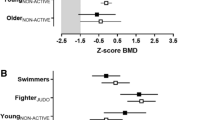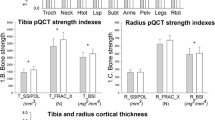Abstract
Summary
The submarine environment is unique in that there is limited space and no sunlight, which may negatively affect skeletal health and lead to accelerated bone loss, osteoporosis, and fractures.
Introduction
The primary purpose of this study was to determine whether there was an association with submarine service, specifically time spent at sea, and bone mineral content (BMC) and bone mineral density (BMD) of the lumbar spine and dual proximal femur (total hip and femoral neck) measured by DXA.
Methods
This is a cross-sectional study of 462 submariners 20–91 years old. Variables included in the analysis were age, height, race, alcohol intake, tobacco use, fracture history, conditions, and medications known to cause bone loss and osteoporosis and submarine service.
Results
Of the submarine service predictors, only serving onboard a diesel submarine was determined to be independently associated with a reduction in BMD of the total hip and femur neck, while no submarine service predictor increased the odds of having low BMD. In submariners 50+ years old, the age-adjusted prevalence of osteopenia was 15.7 % (lumbar spine) and 40.4 % (femur neck), while the prevalence of osteoporosis was 4.8 % (lumbar spine) and 4.2 % (femur neck), rates that did not differ from NHANES 2005–2008. In submariners <50 years old, 3.1 % was below the expected range for age. The proportion of submariners 50+ years old that met the FRAX criteria for pharmacological treatment was 12 %.
Conclusions
Intermittent periods of submergence that can range from a few days to 3+ months do not appear to compromise skeletal health differently than the general population.
Similar content being viewed by others
References
Hannan MT, Felson DT, Dawson-Hughes B, Tucker KL, Cupples LA, Wilson PW, Kiel DP (2000) Risk factors for longitudinal bone loss in elderly men and women: the Framingham Osteoporosis Study. J Bone Miner Res 15:710–720
National Institutes of Health Development Panel on Osteoporosis Prevention, Diagnosis, and Therapy (2001) Osteoporosis prevention, diagnosis, and therapy. JAMA 285:785–795
World Health Organization (2008) Assessment of osteoporosis at the primary healthcare level. Summary report of a WHO scientific group. WHO, Geneva, pp 53–70
Dawson-Hughes B, Looker AC, Tosteson AN, Johansson H, Kanis JA, Melton LJ 3rd (2012) The potential impact of the National Osteoporosis Foundation guidance on treatment eligibility in the USA: an update in NHANES 2005–2008. Osteoporos Int 23:811–820
Oden A, McCloskey EV, Johansson H, Kanis JA (2012) Assessing the impact of osteoporosis on the burden of hip fractures. Calcif Tissue Int 92:42–49
Center JR, Bliuc D, Nguyen TV, Eisman JA (2007) Risk of subsequent fracture after low-trauma fracture in men and women. JAMA 297:387–394
Bliuc D, Nguyen ND, Milch VE, Nguyen TV, Eisman JA, Center JR (2009) Mortality risk associated with low-trauma osteoporotic fracture and subsequent fracture in men and women. JAMA 301:513–521
Orwig DL, Chiles N, Jones M, Hochberg MC (2011) Osteoporosis in men: update 2011. Rheum Dis Clin North Am 37:401–414
Looker AC, Melton LJ 3rd, Harris TB, Borrud LG, Shepherd JA (2010) Prevalence and trends in low femur bone density among older US adults: NHANES 2005–2006 compared with NHANES III. J Bone Miner Res 25:64–71
Baim S, Binkley N, Bilezikian JP, Kendler DL, Hans DB, Lewiecki EM, Silverman S (2008) Official Positions of the International Society for Clinical Densitometry and executive summary of the 2007 ISCD Position Development Conference. J Clin Densitom 11:75–91
National Osteoporosis Foundation (2013) Clinician’s guide to prevention and treatment of osteoporosis. National Osteoporosis Foundation, Washington, DC, pp 1–53
Messier AA, Cohn SH, Neer RM, Vaswani A, Tappan DV, Bondi KR (1981) Assessment of bone and body composition in recently retired and active duty submariners. FASEB J 920
Duplessis CA, Harris EB, Watenpaugh DE, Horn WG (2005) Vitamin D supplementation in underway submariners. Aviat Space Environ Med 76:569–575
Holy X, Collombet JM, Labarthe F, Granger-Veyron N, Begot L (2012) Effects of seasonal vitamin D deficiency and respiratory acidosis on bone metabolism markers in submarine crewmembers during prolonged patrols. J Appl Physiol 112:587–596
Luria T, Matsliah Y, Adir Y, Josephy N, Moran DS, Evans RK, Abramovich A, Eliakim A, Nemet D (2010) Effects of a prolonged submersion on bone strength and metabolism in young healthy submariners. Calcif Tissue Int 86:8–13
Al-Ibrahim MS, Gross JY (1990) Tobacco Use. In: Walker HK, ed. Clincal Methods: the history, physical, and laboratory examinations. Butterworths, Boston Ch 40
Hamdy R, Kiebzak GM, Seier E, Watts NB (2006) The prevalence of significant left-right differences in hip bone mineral density. Osteoporos Int 17:1772–1780
Whyte MP (2005) Misinterpretation of osteodensitometry with high bone density: BMD Z > or = + 2.5 is not “normal”. J Clin Densitom 8:1–6
Kanis JA, Gluer CC (2000) An update on the diagnosis and assessment of osteoporosis with densitometry. Committee of Scientific Advisors, International Osteoporosis Foundation. Osteoporos Int 11:192–202
Holick MF (2003) Vitamin D: A millenium perspective. J Cell Biochem 88:296–307
Yarnall NJ, Hughes LM, Turnbull PS, Michaud M (2012) Evaluating the effectiveness of the US Navy and Marine Corps Tobacco Policy: an assessment of secondhand smoke exposure in US Navy submariners. Tob Control 22:66–72
Schillaci RF (1965) Control of the chemical constituents of the submarine atmosphere (U). U. S. Naval Submarine Medical Center 1–44
Schaefer KE, Pasquale S, Messier AA, Shea M (1980) Phasic changes in bone CO2 fractions, calcium, and phosphorus during chronic hypercapnia. J Appl Physiol 48:802–811
Drummer C, Friedel V, Borger A, Stormer I, Wolter S, Zittermann A, Wolfram G, Heer M (1998) Effects of elevated carbon dioxide environment on calcium metabolism in humans. Aviat Space Environ Med 69:291–298
Notelovitz M (1993) Osteoporosis: screening, prevention, and management. Fertil Steril 59:707–725
Khosla S (2010) Update in male osteoporosis. J Clin Endocrinol Metab 95:3–10
Cawthon PM, Ewing SK, Mackey DC et al (2012) Change in hip bone mineral density and risk of subsequent fractures in older men. J Bone Miner Res 27:2179–2188
Acknowledgments
We would like to extend our gratitude to our subjects for their participation in this study. In addition, we would like to thank the Commander, Submarine Force, and Submarine Force Atlantic Medical Officer (Commander Jeffery McClellen) for their permission to conduct this investigation. We would also like to thank Dr. Scott Smith, Dr. Jean Sibonga, Dr. Robert Ploutz-Snyder (NASA), LT Joshua Swift (Armed Forces Radiobiological Research Institute), and CDR Fred Yeo for their contribution towards improving the quality of this research/manuscript. Additional thanks are warranted to HMCM Darrin Way, Ms. Abaigeal Caras, Mr. Andrew Way and Mr. David Kerr (NSMRL), and the Radiology Department (Naval Branch Health Clinic, Groton) for their technical assistance with this research. Finally, we acknowledge the work in undersea medicine conducted over the years by the former Dr. Wayne Horn (deceased) that planted the seed for this research.
Funding/support
This work was supported by the Office of Naval Research, Warfighter Performance Department (Code 34), work unit number N0001411WX20143.
Disclaimer
The views expressed in this article are those of the authors and do not necessarily reflect the official policy or position of the Department of the Navy, Department of Defense nor the US Government.
Conflicts of interest
None.
Author information
Authors and Affiliations
Corresponding author
Rights and permissions
About this article
Cite this article
Gasier, H.G., Hughes, L.M., Young, C.R. et al. The assessment of bone mineral content and density of the lumbar spine and proximal femur in US submariners. Osteoporos Int 25, 2225–2234 (2014). https://doi.org/10.1007/s00198-014-2753-y
Received:
Accepted:
Published:
Issue Date:
DOI: https://doi.org/10.1007/s00198-014-2753-y




